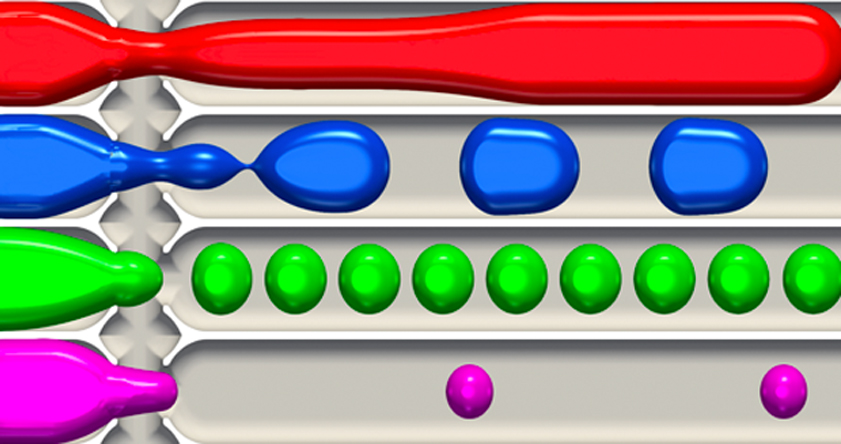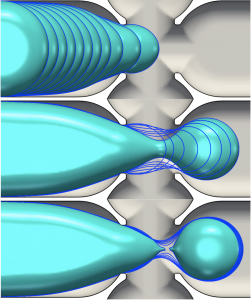Article by Dora Olah, final year undergraduate student in the Department of Chemical Engineering
A new method of simulating fluid flow in unusual pipe structures can pave the way for manufacturing better microfluidic devices. In a new paper, published in Microfluidics and Nanofluidics, researchers from Imperial have used a new way of simulating flow in a cross-junction. They constructed the junction using a combination of simple geometries, such as tori and cylinders, to have a resulting structure which involves oblong-shaped pipes and a thinning cylindrical cross-junction.
The researchers simulated two-phase fluid flow through the cross-junction with varying flow rates, viscosity and interfacial tension. They showed that the fluid breaks up into a variety of different shapes depending on the parameters. The formation and vorticity of these shapes – jets, oval plugs, pancakes and spherical drops – can be simulated with millisecond accuracy and the model shows extremely high level of agreement with experimental data.

According to the study, this method can be applied to other cross-junction geometries easily as the construction of the structure from simple shapes is straightforward and quick. They showed that in this combination of fluid properties, the flow is dominated by pancake and plug formation. The research marks the first time direct numerical simulations of the full Navier-Stokes equation were used for microfluidics, and it can potentially open ways for more complex models such as the involvement of surfactants, phase changes or reactions.
Two-phase fluid flow in microchannels is important in many applications, such as inkjet printing or lab-on-a-chip technology. In addition to the difficulties associated with the micro-scale pipe size, fluid flow in microchannels can be further complicated if there are unusual geometries involved.

In real-world applications, there are often co-flowing or cross-flowing streams, as well as T-junctions and cross-junctions. Furthermore, these junctions often have thinner cross-section than the rest of the pipe, which causes the flow to break up into smaller droplets as it is flowing through. A reliable way of modelling these complex structures and the flow patterns after the breakup was previously not available, despite the wide-ranging industrial interest in microchannel flow properties.
The front-tracking approach used in the study has high industrial relevance in the microfluidic device manufacturing and the model shown in the paper allows for easy and quick modification of the geometry of the junction, which in turn helps the simulation of any flow pattern with minimal computational effort. In the future, researchers are hoping to utilise the model for three-phase flows and non-Newtonian fluids, as well as surfactants.
Find out more about the Matar Fluids Group research on their website.